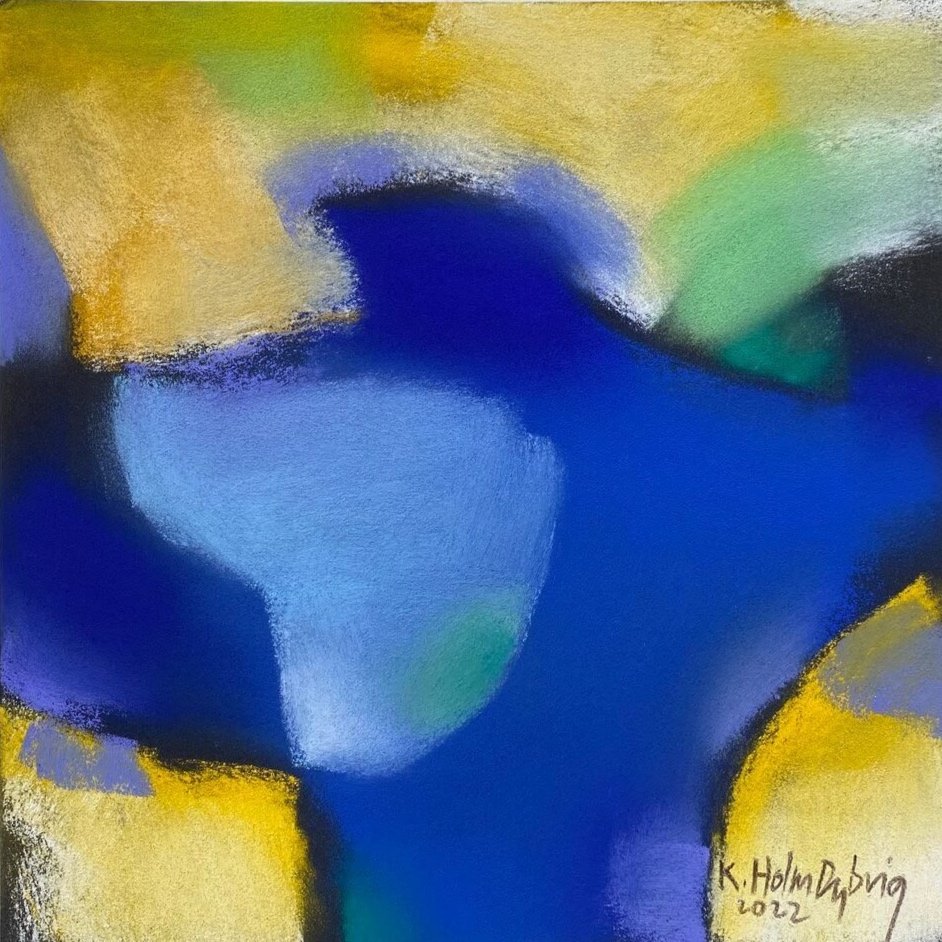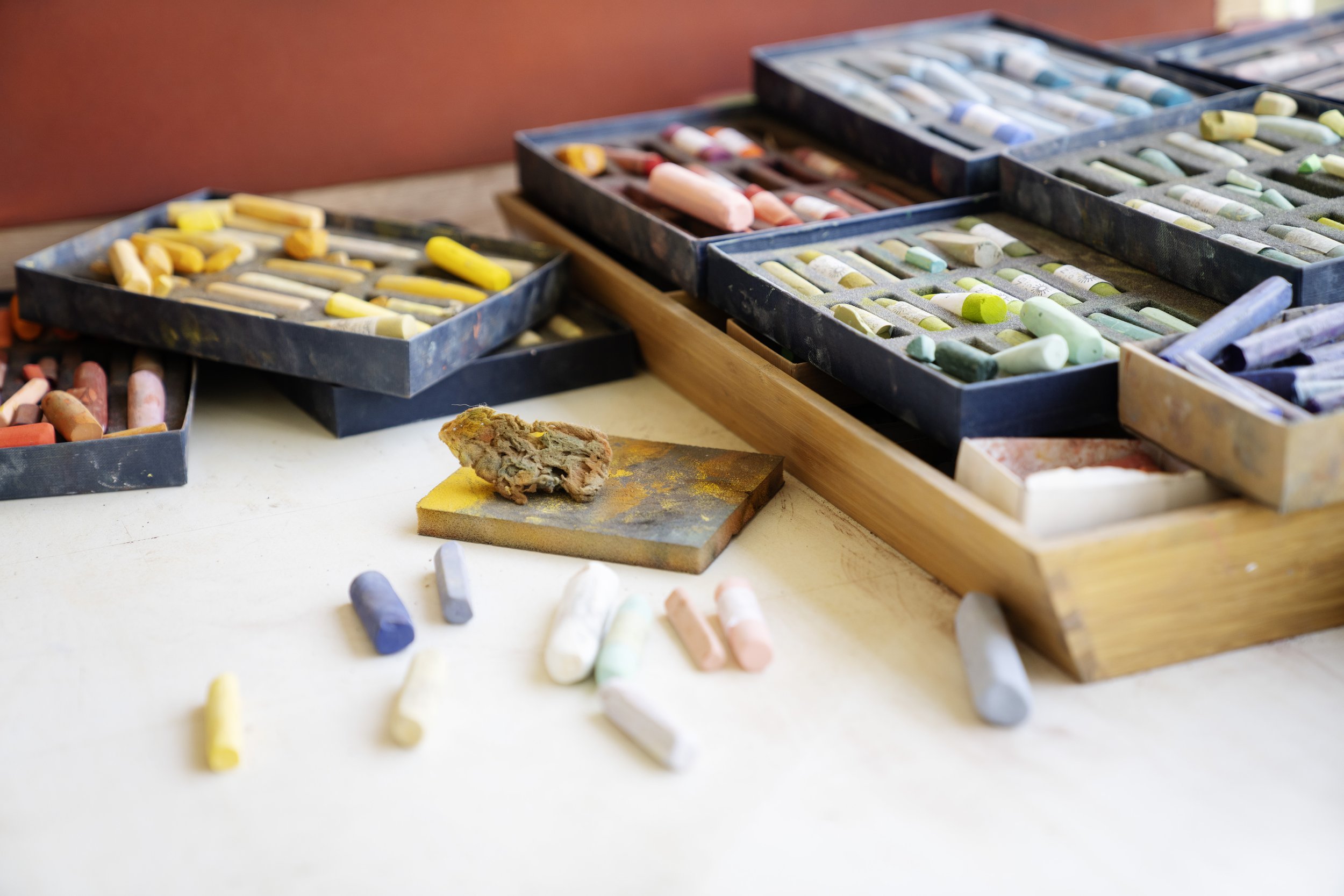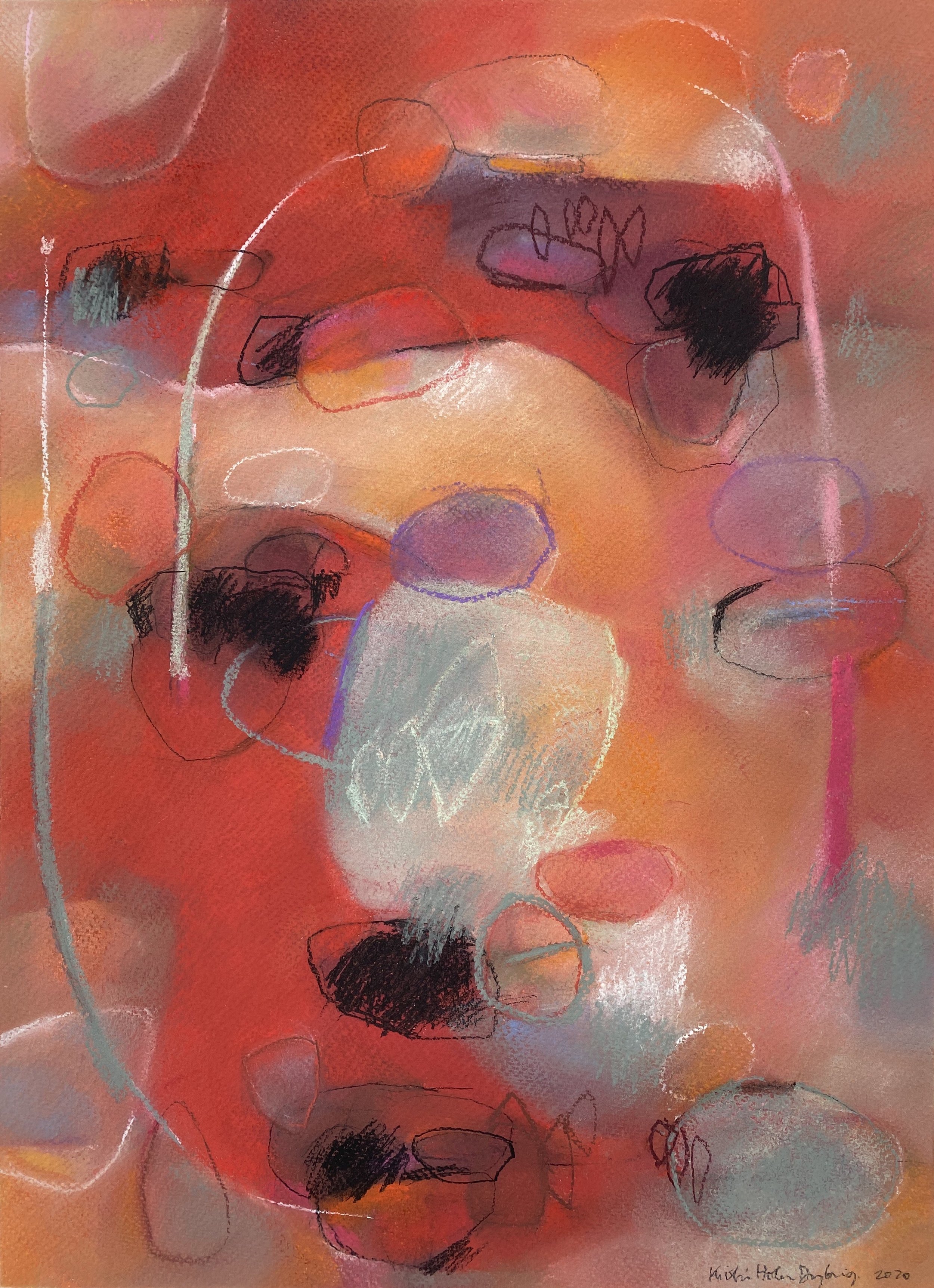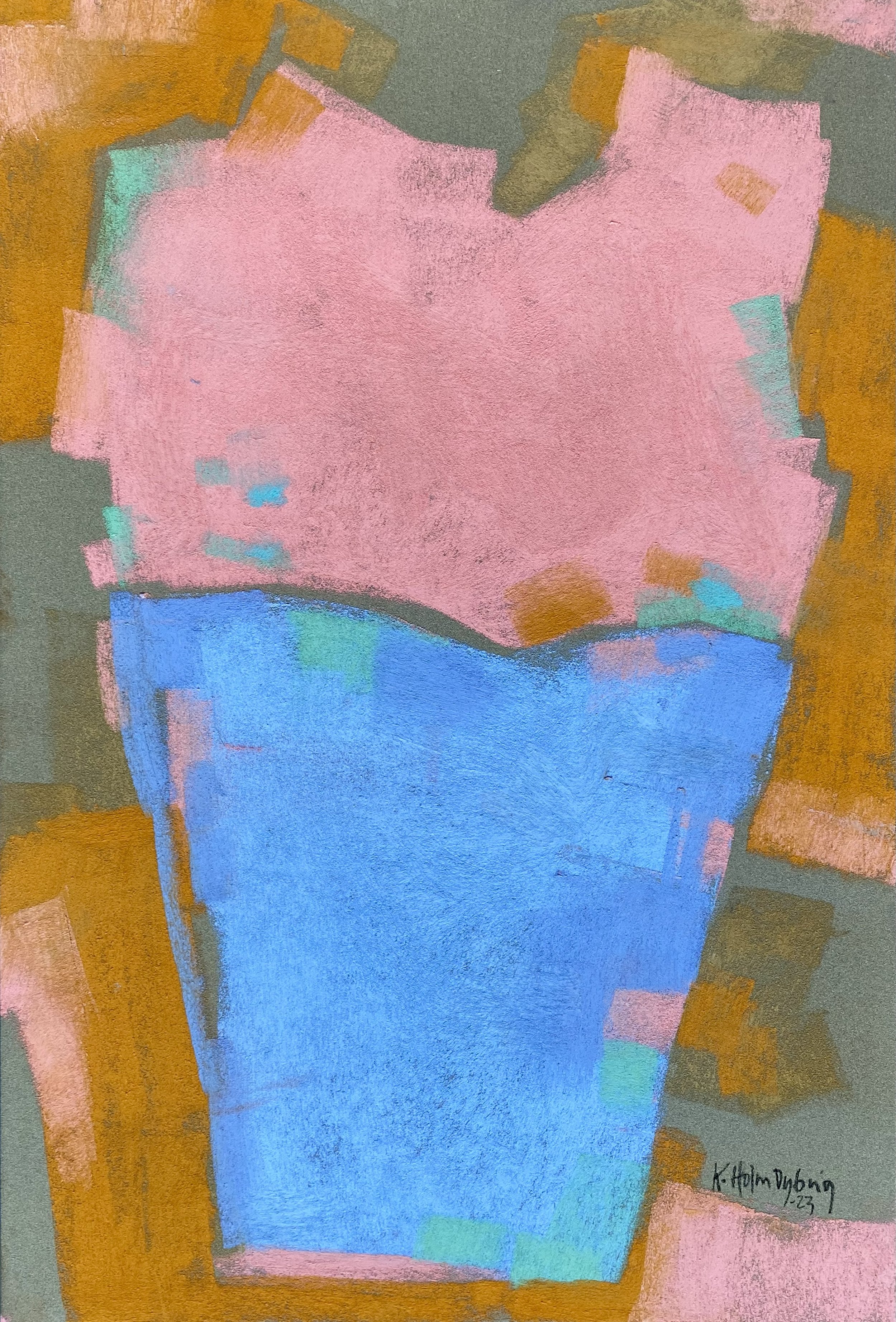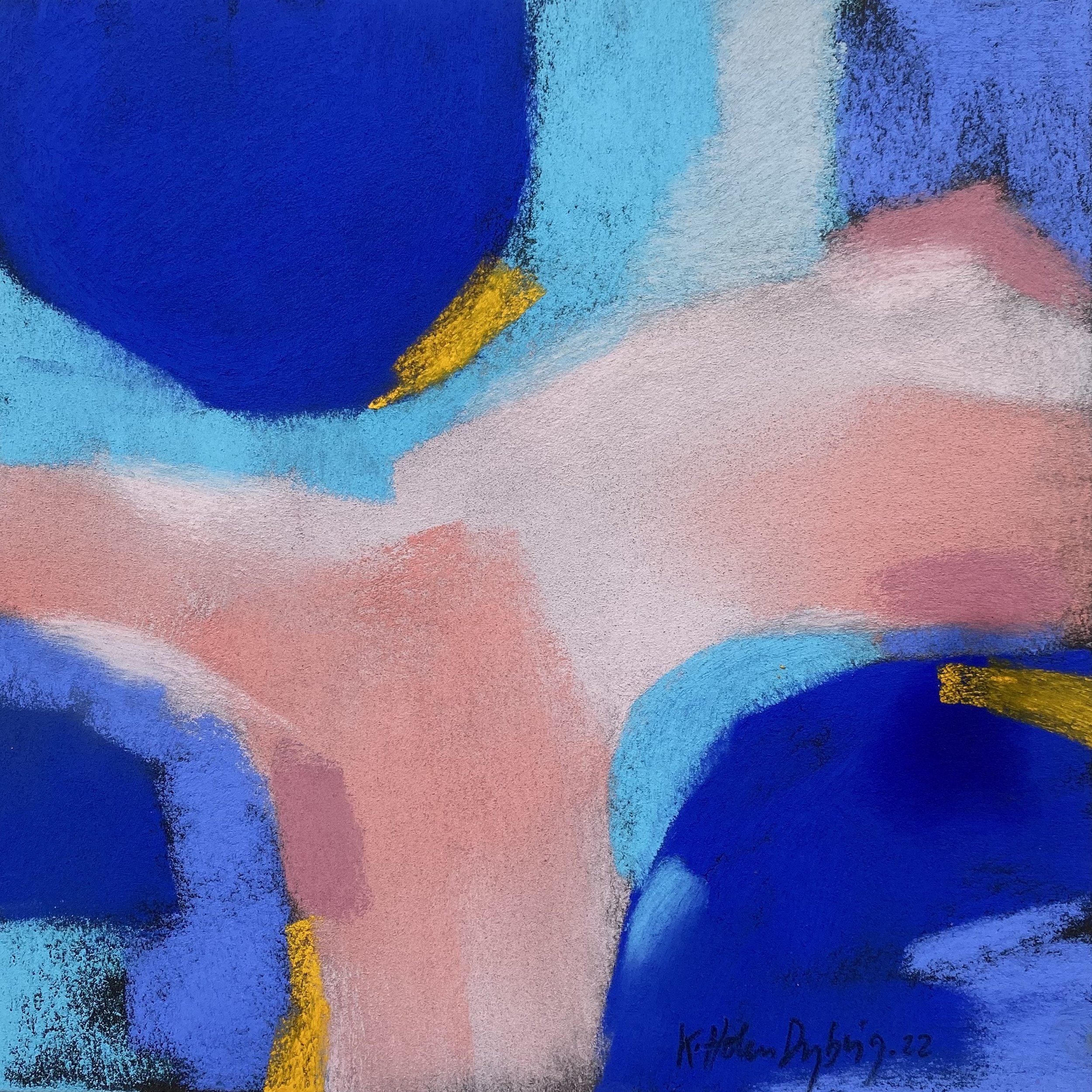Interview
Return on Art
ARTIST SPOTLIGHT
Read our interview with the Norwegian art therapist turned artist who creates gentle abstracts with dry pastels and hands.
Kristin Holm Dybvig - Artist Spotlight
Updated on March 2023 by Marieke De Kan
"Colors speak the language of my soul and never cease to fascinate and inspire me, providing endless possibilities for exploration."
Kristin Holm Dybvig lives on the West Coast of Norway, close to fjords and mountains, on the edge of the North Sea. The colors of this beautiful ever-changing landscape form an endless source of inspiration for her work, in which she converts visual memories into vibrant 'Color Poetry'. The artist prefers to create with dry pastels, working in an intuitive and immediate way, using her hands as tools. This results in works that emanate an ethereal feeling - a certain softness that one rarely encounters in other media. Dybvig’s works are a vibrant exploration of the inherent luminosity and vitality of the colors surrounding her - the dialogues, movements, and flow that affect their character and how to translate them into gestures, shapes, and lines.
INTERVIEW WITH THE ARTIST
Q. Your professional path seems to have meandered over the years, how did you come to pursue a career as an artist?
A. My career has taken me on different paths over the years, it has been varied and it has given me opportunities and challenged me to grow - but it has always been about creation with color. I got my first job as a graphic designer at a small art shop when I was 19 and full of courage to take on the world. I then changed jobs again at the beginning of the summer, as I wanted to go traveling - there were plenty of jobs after all. Finally, I ended up being an Art Director at an advertising agency, where I stayed on for many years before feeling like I needed a change and moved to England to study art and art therapy. Back home after 4 wonderful years, I worked as an art therapist with children and young adults, only taking short breaks to have my daughters. During this time, I managed to do some painting on the side, but then I got ill and had to take a big break. During my slow recovery process, I decided that I finally wanted to pursue my art. That this was a missing element in my life and that, at this point in time, I had a unique chance to go ‘all in’. My daughters were old enough and I was dedicated. I realized that I had to pursue this infatuation that had been central to my life for all these years and which I hadn’t given a serious chance to blossom. In doing so, it was imperative to me to follow my number one passion - to create art with color.
In my opinion, all experience has a transfer value. I’m grateful for the insights life has provided me and the opportunities to grow in step with the acquired experience. Today, I fill my artwork in terms of content from a profound comprehension of myself and my surroundings that would have been impossible only a few years back. The wish to explore these aspects of my life has increased gradually since my teens until it has become imperative to do so. Finally, it has come to fruition through the beautiful and deeply fascinating language of art. It’s truly satisfying to use all the skills acquired through my previous careers to create the best paintings possible.**
Q. Your works seem to convey both a serene and a dramatic sensibility is this a field of tension you consciously look to evoke?
A. I think it is. The drama and tension make the artwork more interesting and for me it is a creative challenge to bring tranquility and a sense of calmness into this equation. The drama is always there, in these landscapes surrounding me, but my images of lyrical landscapes are not depictions of actual places. They are made from memory and one could call them soul moods, as they express emotions and a state of mind as much as the landscape itself. In my abstract works, you can see the same; there, I just express it as a pure color mood instead of using the landscape to express my vision. I call this ‘color poetry’. I like to paint serenity and calmness into my artworks and to think of myself as a conservator of quiet moments and blissful transience. I want to imply that calmness already exists within the moment captured and that drama is just the other side of the coin. I want the viewer to perceive the drama, the transience and the fragility that are part of life - to show them the abundant beauty as well as the vulnerability. Nature in itself is the source of a certain calm and serenity that I want to capture in my artwork. I find that this aspect is best articulated with drama to serve as a contrast or a backdrop.
I want to visualize the abundant beauty and vulnerability of nature through the veil of time by transforming my memories into vibrant color.
Kristin Holm Dybvig
Horizons. Cascades #6
Soft Pastels on Cotton Paper
(Soon available on ROA)
Q. Is your work a direct reflection of your current living environment – the impressive Norwegian landscape - or are the vistas you depict rather imagination-based?
A. I am interested in how colors appear and change in accordance with the seasons. I rework memories from walks and journeys into colorful abstractions. I want to convey my personal perception of the old landscapes to the viewer, to invite them into these enchanted places and open their hearts to my vistas. I want to visualize the abundant beauty and vulnerability of nature through the veil of time by transforming my memories into vibrant colors. Concrete memories fade and leave me with a specific mood or color impression. I am drawn to the timelessness I find in nature. When there are no new elements added, the landscapes convey a strong feeling of longevity. This quote by G. C. Tobler about nature says it nicely:
She (nature) brings forth ever new forms: What is there, never was; What was, never will return. All is new and yet forever old.
These landscapes make it easy to feel connected to the past. By conserving those moments and memories in my artwork, I create my own brand of permanence. I bring together the past and the present, whilst creating something that will last in the future.
Q. What made you settle on soft pastels as your medium of choice? And do you use any other tools in your creative process?
A. This medium fits my work mode and my personality well. It challenges me to be selective and deliberate in how I build up my compositions and to make sure that color is the central focus of each artwork. I’m a tactile person and enjoy the feeling of the dusty pigments in my hands and the slow process of building an artwork in soft pastels suits my temper. I use my hands and fingers to smudge, mix and shape the colors. I use erasers, sandpaper, brushes, and pastel pencils to add effects. The process of creating depth and sculpting the colors, adding and subtracting lasts until the piece has become my personal interpretation of the land or the memory, like a moment captured.
Soft pastels have an exceptional degree of intensity, the vibrancy and purity of the colors and the way they carry their inherent luminosity are fantastic and as close to my perception as I have found in any medium. This, combined with a beautiful silky matte surface, make it an interesting and inspiring medium to work with, which leaves the viewer with a beautiful artwork that I’m proud of and enjoy.
Q. You work intuitively with pastels, creating compositions in between imagined landscapes and memories. What mood do you aim to evoke in your art and what do you hope viewers see in it?
A. I use elements of nature and the land surrounding me to express emotions and a state of mind. I think it’s important to remember that we and nature have the same origin, it’s just different expressions of life. My hope is that the viewer will sense the reverence for nature, recognise the elemental connection and perceive the emotions of the remembered moment captured in my art. I perceive much of my environment through color and see in nature an abstract imagery that becomes part of the palette I work from. I live between the sea and the fjords, between majestic mountains and open horizons, the inspiration is close by. In my work, whether I keep it as a pure color mood, where I’m weaving colors, to pulsing abstracts, or I’m using the suggestive landscapes to express my vision, I’m revealing emotions and using the intensity of the pastels to amplify the intention of my art. I want to create art that celebrates life and touches the viewer deeply. Color is imbued with the power to reach from person to person, it’s this incredibly strong, non-verbal language that conveys emotions so precisely. I use it to transmit my visions to the paper so it can connect with the viewer on an emotional level. I hope that the viewer will recognize something in themselves, in the belief that all emotions are universal, our lives are similar, different, but essentially alike, and that the universal language of color has the power to reach all the way and touch another soul.
Q. Have you always felt a strong connection to nature or is this something that developed over time?
A. Nature represents a place of relaxation, inspiration, challenge, and beauty to me. This relationship grew into something very intimate and personal during my childhood, as it was a unifying ingredient within my family. We went for walks, did gardening, and took care of the land together - these were important elements that my parents enriched our childhood with and this is how nature became an integral part of our life. For me and my siblings, it still is. This relationship with nature has grown into a strong and personal connection that provides food for my curious mind and forms an endless source of inspiration to me as an artist.
Q. There seems to be an almost poetic element to your compositions is poetry a source of inspiration or is it rather about the creation of color harmonies?
Painting with color on white paper is like writing a poem or composing a piece of music - I’m composing color poetry.
My lifelong passion for color unfolds itself in my artwork. I like to weave the colors into poetic color-moods using a lyrical palette. For as long as I can remember I have had color memories. I perceive much of my surroundings through color and experience nature often as abstract imagery. Beautiful colors, vibrant or soothing, surprising, and fun, all of them, wherever they appear, continue to fascinate and inspire me. The moods I’m after and want to depict in my artwork are often connected to my past, to personal experiences or impressions.
Memories fade, but, for me, the colors remain. I still have colorful memories from my very early childhood. It’s as if my senses always were, and still are, open and perceptive to polychromatic impressions, impressions that stay with me as colorful moods. When I create with color, memories come back to life, brought back through the associations that colors evoke. They pop up as vivid short videos and take me back in time. I find that these memories have passed the test of time - they represent an essence or a tiny time capsule. Capturing these memory moods in my work feels important and freeing. Incarnating them on paper is a way to see them with new eyes, with a new sense of perception, and from a very different place in my life. However, it remains important for me to rework the piece and make it an artwork in its own right. It has to work on the paper, but it has to add something to the here and now as well. It has to become a well-composed poem that stands on its own, completely independent of its origin.
Kristin Holm Dybvig
Summer Garden 2, 2019
Dry Pastels on Cotton Paper
Q. Does where you live influence your work?
A. In a way it doesn’t matter where I live – I like to believe that if I lived in a totally different environment I would relate to that place, feel the connection and be as curious about it and the lives lived there as I’m here. The colours, the light and the mood of the land would differ but my perception of it and the need to explore it would be much the same. My artwork would probably look different but as it would be created out of the same inception, I think it would be recognizable. I wish to stay for a while when I visit new places, to experience a landscape with different qualities and to let it touch me and my art. I think it to be be highly beneficial and interesting. I find much inspiration on my trips, long and short, far or close by, walking, driving or boating. This summer, I visited friends living further north, crossed over highlands and mountains, travelled out to the sea and journeyed along the coast. I collected more light, more sky, more mountains and open horizons and my artwork has benefited from it. I think that every artistic process is a subjective interpretation of an objective reality, and my paintings are no exception. They are built on my subjective impressions of my reality.**
Q. What would you say has been the most challenging aspect of being a full-time artist? The most rewarding?
A. The challenge is to be seen and to have my art communicated to a larger audience. I live at the outskirts of the world. This is a fact even today when the world has come together on social media, making it so much smaller. My day is threefold; First of all, I create works of art, and secondly, I do marketing, mainly by using the social media channels. I find that social media is the fastest solution to communicate with and increase an audience. That it gives me the opportunity to connect with colleagues, art lovers, collectors and curators from around the world is simply awesome. My experience from the advertising industry comes in handy and helps me figure out and understand the importance of this part of my job. The third part is to administer, taking care of all the practical and administrative tasks, like sorting and answering all incoming emails with fantastic opportunities, bad offers and good questions, sales and shipping. This part of my job provides me with ample opportunities to meet people which is a big bonus.
The response I get back from my viewers is valuable and a great support but also a huge motivator to get better at communicating what my work is about and how I think about it. This is important for all parts of my job. All three parts are challenging with redeeming qualities, but the most rewarding aspect is undoubtedly to engage in the creative process. This is my happy place. I have a strong wish to go above and beyond every time, to create a more interesting, more authentic and original work of art is an inspirational challenge that urges me on. Walking ahead into the unknown, developing and adding new aspects to my work is inspiring. When the painting becomes a direct echo of my inner self it starts to sing. Time stops and it becomes independent of me and gets its intrinsic value.**
Kristin Holm Dybvig
Flower Pot, 2023
Soft Pastels on Sanded Paper
(Soon available on ROA)
Q. Which other creatives do you admire?
A. There are so many! Both from the past and the present - some contemporaries because of their achievements and work with color, some important historical figures for their contributions to the art world. Basically, there is always something to admire; I could mention Helen Frankenthaler and Georgia O’Keeffe - they both have inspired me with their art and lives, and they are formidable role models. There are many lesser-known artists I could have mentioned, who are as important to me. I wish the big and important art institutions would afford female painters as much space and attention as their male counterparts. Then there would be many new names to know and many more exciting artists to explore.
I would also like to mention my fascination with Asian art. The work and ideas of Chinese artists such as Canal Cheong Jageroos and Yang Din are so inspiring to me. The aesthetics of Japanese minimalism are also close to my heart, as is the book “One Hundred Famous Views of Edo”, which has strongly influenced my work.
Q. Could you describe your work in three words?
A. This is a tricky question since I love to use many words. I think my work is distinctly feminine with a dash of naiveté. I like to think of myself as a colorist, who picks up where the fauvists left off. My connection to color is my force, it is my starting point as well as my safe place. I would like to say that I create Color Poetry and Lyrical Landscapes, but that’s more than three words, so I think I go for; Ethereal Colour Moods - as that also captures the unique quality of soft pastels.
** excerpts from an interview on Parter, written by Alicia Puig
Published on March 2023Updated on March 2023by Marieke De Kan

